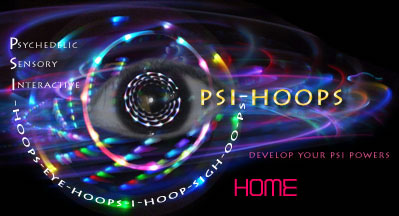
 |
 |
 |
|||||||||
 |
|||||||||||
 |
 |
 |
|||||||||
 |
|||||||||||
Your psihoop is made with rechargeable batteries. I used to make the hoops with regular batteries, which fit in a compartment near the connector. The downside of this was that the hoop was not perfectly balanced and so didnt spin true. Now I space the batteries evenly around the hoop and they stay inside the hoop to be recharged. NOTE: The main concern with using rechargeables in the hoops is that it is hard (difficult to impossible) to change them when their life is up. They are supposed to have about 1000 charges in them, according to the manufacturer, but as we know “Your mileage can vary”. In order to fix the batteries in the hoop at even intervals I have used hot glue injected into the tubing after everything else is in place. This stops the batteries from rattling around and breaking connections and smashing LEDs and so forth. But I then have to chop the tubing apart in 6 places to get the batteries out. At first I thought this was a fair trade off for a performance hoop that could be used 1000 times. But in order to increase your chances of getting anywhere near 1000 fully lit nights of hooping you need to treat the batteries a certain way… . Each charge will take about 10 hours but you can leave them on the charger for several hours longer without hurting them. Don't leave them on charge all the time, though, as that will shorten battery life. Also don't let them go for months without a charge, as that will also shorten battery life. The motto is “Hoop regularly!”. I have recently (August 2006) started to make the hoops so that the batteries can be changed when they aren't producing the intensity and length of lit time that you want. Changing batteries will still be a time consuming operation, but I wont have to break the tubing apart. The cost for replacing the rechargeable batteries will depend on the hours it takes me, and the cost of materials and new batteries etc, so it will probably be around $60 -$100. Batteries are not covered by the warranty, unless defective on arrival or during the first 6 months.
I started making the hoops with regular batteries because I didnt want to mess with chargers, and I liked the convenience of being able to change batteries at any time. There were some disadvantages to the regular batteries: they are costly to keep replacing; they pollute the environment; they imbalance the hoop because they all have to be put together in a compartment. This compartment also was a weak point in the hoop construction and some people had trouble with the connections. Thus I have switched to rechargeable batteries.
The best way to handle the charging of your Psihoop is to plug it in overnight the day before you will need it. There is an adaptor included. Note for International users – the charger and hoop are set for American voltage which is 110-120 and NOT for 240 Volts (England and Australia and others)…if you have 240 Volts you will destroy the charger and possibly the hoop unless you put the voltage through a transformer to change it to 120 and then use an adaptor to get the right plug. To repeat: Note that this adaptor is for US voltage only and if you take the hoop to a country with a different current supply you will need the appropriate transformer.A fully charged psihoop is designed to give you enough lit time for a full night of performance or play. The actual hours will vary from hoop to hoop depending on the number and type of LED, the type and size of the battery and so on ( hmmmm, your mileage may vary...) The AA batteries will powere a hoop with 16 LEDs for over 4 hours of brightly lit time. As the batteries start to lose their power the lights will dim and go redder. This phase can last up to several hours, until the hoop dims out totally. Depending on the circuitry inside this dimming and reddening effect can be faster or slower. The colors and effects of the hoop are quite pleasing during this phase, so its worth letting the hoop run down and seeing for yourself. AAA batteries can be used in the smaller tubing (the 3/4" OD) because the AA batteries are heavier and only just fit in that tubing. The problem with that snug fit is that in the cold weather the tube will shrink slightly and then if you bang or drop the hoop on a hard surface and it hits just where a battery is located, the tube can crack. You should email me if you want to discuss this. . The AAA batteries last for about a quarter to a half the time of the AAs, but still give at least 1 hour of good lit time, and over an hour more of redder light. If you turn the hoop off between performances or dances, that is still a long time to have the hoop lit. The AAAs will save about 2 ounces of weight, which is considerable in the smaller hoops with thin tubing . Your hoop can be charged from a generator (at Burning Man etc) or a car. A full charge can take around 10 hours.
|